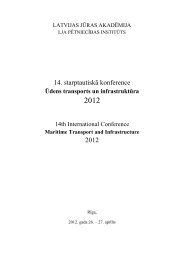You also want an ePaper? Increase the reach of your titles
YUMPU automatically turns print PDFs into web optimized ePapers that Google loves.
F4: M/E Cylinder Cooling Water Outlet Temperature High High (Slow Down) F5: M/E Cylinder Cooling Water Low Inlet Pressure F6: M/E Cylinder Cooling Water Inlet Pressure Low Low (Slow Down) F7: M/E Cylinder Cooling Water High Outlet Pressure F8: Cooling Water High Temperature Turbo Charger (T/C) Outlet F9: M/E High Temperature Fresh Water (HTFW) Low Level Expansion Tank F10: M/E HTFW High Level Expansion Tank F11: High Sea Water Pressure F12: Low Sea Water Pressure F13: Sea Water Pressure Low Low (Slow Down) F14: High Sea Water Temperature F15: M/E Low Preheating Temperature (Don't Start the Engine) F16: Low Temperature Fresh Water (LTFW) Low Level Expansion Tank F17: LTFW High Level Expansion Tank F18: LTFW High Temperature F19: LTFW High Pressure F20: LTFW Low Pressure F21: M/E LTFW Air Cooler High Inlet Temperature F22: M/E LTFW Air Cooler Low Inlet Pressure F23: M/E LTFW Air Cooler High Inlet PressureCauses of failuresFigure 2. General flow diagram [10]The causes of the failures are coded as C1, C2, C3, ...., Cn and controls and interventions that mustbe made in accordance to these causes are coded C1A1, C1A2, ...., C1An. This coding system is shownand exemplified with an alarming condition that is given below. F is the alarm condition in the systemthat is explained before and C refers to the reason of the alarm and A is the order of the action that mustbe made to resolve the alarming condition.64
















